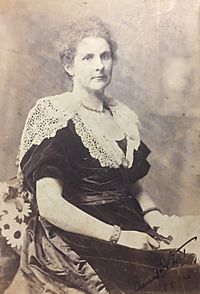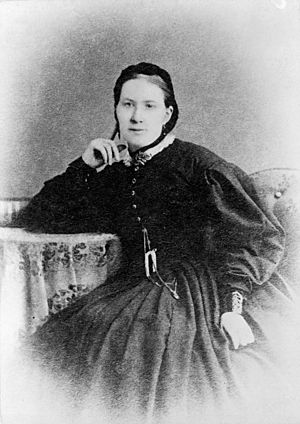Anna Stout facts for kids
Quick facts for kids
Anna, Lady Stout
|
|
|---|---|
 |
|
| Spouse of the Prime Minister of New Zealand | |
| In role 16 August 1884 – 28 August 1884 |
|
| Prime Minister | Robert Stout |
| Preceded by | Annie Atkinson |
| Succeeded by | Annie Atkinson |
| In role 3 September 1884 – 8 October 1887 |
|
| Prime Minister | Robert Stout |
| Preceded by | Annie Atkinson |
| Succeeded by | Annie Atkinson |
| Personal details | |
| Born |
Anna Paterson Logan
29 September 1858 Dunedin, New Zealand |
| Died | 10 May 1931 (aged 72) Hanmer Springs, New Zealand |
| Spouse | Robert Stout |
| Children | 6, including Duncan |
| Known for | Social reform and feminisim |
Anna Paterson Stout, Lady Stout (born Logan; 29 September 1858 – 10 May 1931) was an important social reformer and activist. She worked hard for women's rights in both New Zealand and Britain.
Contents
Early Life and Family
Anna Paterson Stout was born in Dunedin, New Zealand, in 1858. Her parents, Jessie Alexander Pollock and John Logan, were from Scotland. They were very active in movements to improve society. These movements included the temperance and freethought movements. These ideas greatly influenced Anna throughout her life.
From age 12, Anna studied at the Otago Girls' High School. She lived with her parents in Dunedin until she got married. In December 1876, at 18, she married Robert Stout. He was a 32-year-old lawyer and a member of Parliament. Robert was a family friend who often discussed big ideas with Anna's parents.
Anna and Robert had six children between 1878 and 1894. They had four sons and two daughters. One of their sons, Sir Thomas Duncan MacGregor Stout, became a strong supporter of education. He was the first leader of Victoria University of Wellington. He also received a special award for his work in medicine and education.
When Robert was given a special honour (knighthood) in May 1886, Anna became known as Anna, Lady Stout.
Fighting for Women's Rights
Anna Stout was a dedicated activist and feminist. She believed strongly that women should have the same rights as men. She also thought women should be free to develop their minds fully. She worked to expand higher education for women. She was especially concerned about education for Māori women.
Throughout her life, Anna worked to teach women about politics. She also campaigned for women to receive equal pay and equal legal rights. Anna and her husband, Robert, shared many similar views. They often worked together with other social reformers and politicians.
As the wife of the Premier (like a prime minister) and later the Chief Justice, Anna became a public figure. This allowed her to meet many important people of her time. These included politicians like Richard Seddon and George Grey.
Joining Important Groups
Anna Stout helped start the New Zealand branch of the Women's Christian Temperance Union New Zealand in 1885. This group worked to reduce the problems caused by alcohol. In the 1890s, she became even more active in public life.
In April 1892, Anna was chosen to lead the Women's Franchise League in Dunedin. She also helped create the National Council of Women of New Zealand in 1896. This group aimed to educate women about politics. It also worked to promote women's independence and equality. Another goal was to improve working conditions for women.
Anna also helped start the Wellington branch of the New Zealand Society for the Protection of Women and Children in 1897. This group worked to keep women and children safe.
After moving to Wellington in 1895, Anna became very active in social events. Her gatherings were often reported in newspapers. She used her position and connections to influence political decisions that helped women.
Activism in England
In 1909, Anna and Robert took their children to England. Robert returned to New Zealand in 1910, but Anna stayed in England. She remained there until 1912 while her children studied. During this time, she joined the British suffrage movement. This movement fought for women's right to vote. She became close with the Pankhurst family and other leaders of the movement.
In England, Anna was able to be more open with her activism. She joined the Women's Social and Political Union (WSPU). This was a strong group led by Emmeline Pankhurst and Christabel Pankhurst.
Because Anna was from New Zealand and women there could already vote, the WSPU used her experience. Anna helped explain to people who were against women voting that it had not caused problems in New Zealand. She often wrote replies to newspapers that opposed women's suffrage. Her articles appeared in magazines like Votes for Women. They were also printed as leaflets by other groups.
Anna took part in public demonstrations. She marched through the streets behind WSPU banners. In 1910, she led a group of New Zealanders in a large protest in London's Hyde Park. She even spoke to the crowd from a platform.
Later Years and Legacy
When Anna returned to Wellington at age 54, she continued to be an active member of various clubs and societies. She joined groups like the English-Speaking Union and several women's clubs. During the First World War, she was part of the Women's National Reserve of New Zealand. In 1917, she helped restart the National Council of Women of New Zealand. After the war, she joined the League of Nations Union of New Zealand.
In her later years, Anna sometimes spoke out in public debates about women's roles. For example, in 1917, she disagreed with ideas to focus only on domestic training for girls. She believed women should have broader educational opportunities.
Anna Stout was not very active in the 1920s due to illness. Her husband, Robert, passed away on 19 July 1930. Anna died less than a year later, on 10 May 1931, at Hanmer Springs. She was 72 years old. Her ashes are buried at Karori cemetery.


